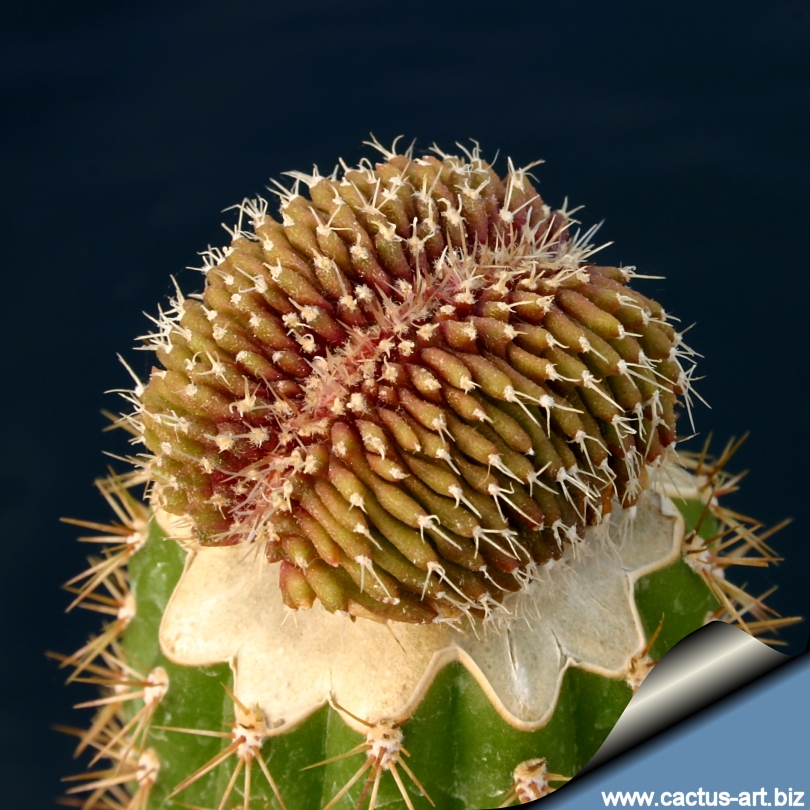|
|
|

Ubelmannia meninensi f. rubra cristata.
This sticking beautiful crest in full sun will take a dark frost
brown or purple colour. |
|
|
Description: U. meninensis is a short columnar
usually solitary cactus.
Stem: Globular when young, later becoming elongated and
cylindrical, greyish-green or reddish-green (f. rubra), 10 cm wide,
45-50 cm tall (In cultivation the colour of the plants depends on sun
exposure, the plants grown in shadow are greener , wile the ones in full
sun take a dark frost brown or purple color)
Ribs: When fully mature it has up to 40 prominent markedly
tuberculate , but initially it has considerably fewer.
Tubercles: The tubercles protrude about 8 mm, are separated by
transverse grooves and have apical areoles.
Areoles: Close set.
Central spines:: 2 or 3, 2 cm long, pointing downward except for
the upper one, which is shorter.
Radial spines: Absent.
Flowers: Diurnal yellow. They are up to 2-4 cm long , 2-4 cm in
diameter.
Blooming season: Flowers come sporadically from Early Summer to Late
Summer
Fruit: Inconspicuous , dark red and globular
Propagation: Seeds, but plants are often grafted making them
easier to grow, particularly through the winter. If possible using
a rootstock that is more hardy than the Uebelmannia is the ideal.
|
|
Photo of conspecific taxa, varieties, forms and
cultivars of Uebelmannia gummifera.
Advertising
|
|
|
|
|
Family:
Cactaceae (Cactus
Family) |
|
Scientific name: Uebelmannia
meninensis var. rubra (Buin.) Buining & Brederoo, Kakteen,
55-56: 106. c., 1973
f. cristata
Tribe: Cacteae -- Subtribe: Echinocactinae
Origin:
Garden origin (Nursery
produced cultivar) This plant
was originally found in Brazil (mountain of Minas Gerais) where it
often grows at very high altitudes.
Habitat: In nature it grows in cracks between rocks or on the
rocks themselves, usually where there is a very high degree of
atmospheric moisture, which compensates for the fact the soil is
perfectly drained. In its natural habitat the plant frequently grows
among lichens, which may even cover it.
Conservation status: Listed in
CITES appendix 1.
Etymology: Named after Werner Uebelmann, the Swiss nurseryman
who imported them into Europe. The species meninensis was found in 1973
by the Dutch botanist Albert Buining growing among quartz rocks near a
place named Padre Menina, hence the name.
|
|
|
Synonyms:
- Uebelmannia meninensis Buining,
In: Kakteen Sukk. 19: 151, fig. 1968
- Uebelmannia meninensis v. rubra P.J.Braun et
E.Esteves, 2000
- Uebelmannia gummifera (Backeberg & Voll) A.F.H.
Buining.
in: Succulenta (Netherlands) 46: 161, 1967
- Uebelmannia gummifera ssp. meninensis (A.F.H.
Buining) P.J. Braun & E. Esteves Pereira
In: Succulenta, 74 (5): 226: 1995
- Uebelmannia gummifera v. rubra (A.F.H. Buining & A.J.
Brederoo) P.J. Braun & E. Esteves Pereira,
In: Succulenta, 74 (5): 226: 1995
- Parodia gummifera Backeb. & Voll
Cultivation: This tropical genus,
which is hardly ever cultivated except in very specialized collections,
prefers loves warm moist, humid conditions and mist spraying is a must
in summer. Water regularly during the growing season and use a very
draining mineral potting substrate. At the onset of winter, do not
water. Uebelmannias need heat all year round and extra winter heat,
minimum 10C is best. Avoid any frost. Keep cool in summer. This plant
prove to be root prone if kept too cold in winter. To help stop this a
good deep collar of pumice or lava grit is an excellent idea. It prefers
a full sun position and possibly afternoon shade in summer. If you can
place it so that this occurs the plant will be much happier.


|
|